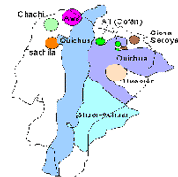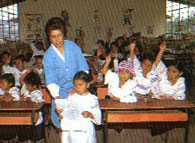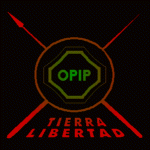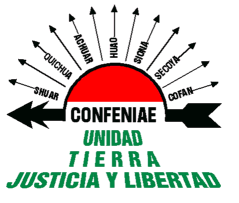The Confederation of Indigenous Nationalities
of Ecuador was founded in Ecuador in 1986 from a collaboration between
ECUARUNARI and CONFENIAE. The Catholic Church influenced the formation
of ECUARUNARI, a regional  organization
of the Sierra, in 1972 (CONAIE, "A Brief History," Dec. 1992). The
organization became increasingly independent over the next decade before
it helped to form CONAIE. CONAIE represents all the indigenous groups
of Ecuador, including those with a formal organization and those without.
To get an idea of where the lands of the indigenous nationalities of Ecuador
are located, click on the map to the right for a larger version.
CONAIE works to strengthen indigenous organizations and help indigenous
communities deal with territorial disputes and unfavorable organization
of the Sierra, in 1972 (CONAIE, "A Brief History," Dec. 1992). The
organization became increasingly independent over the next decade before
it helped to form CONAIE. CONAIE represents all the indigenous groups
of Ecuador, including those with a formal organization and those without.
To get an idea of where the lands of the indigenous nationalities of Ecuador
are located, click on the map to the right for a larger version.
CONAIE works to strengthen indigenous organizations and help indigenous
communities deal with territorial disputes and unfavorable  government
policies. CONAIE also works to promote indigenous cultures and bilingual
education, encouraging people to learn and use their traditional language
alonside Spanish. CONAIE feels that, although language separates
the indigenous groups of Ecuador, the problems they face unite them.
They promote the Quichua language as a way to unite the indigenous groups
(CONAIE's website, mainpage). government
policies. CONAIE also works to promote indigenous cultures and bilingual
education, encouraging people to learn and use their traditional language
alonside Spanish. CONAIE feels that, although language separates
the indigenous groups of Ecuador, the problems they face unite them.
They promote the Quichua language as a way to unite the indigenous groups
(CONAIE's website, mainpage).
CONAIE has supported several uprisings against
the Ecuadorian government. CONAIE was an instrumental participant
in the 500 Years of Indigenous Resistance Campaign. In late May/June
1990, CONAIE organized a peaceful uprising throughout the Sierra.
One million indigenous people stopped working on May 28 and shut the country
down for a week. CONAIE participated in the First Continental Conference
on 500 Years of Indigenous Resistance in Quito, Ecuador, following the
uprising that summer. As part of the campaign, they asked for the
return of traditional community held lands, the recognition of Quechua
as an official language, and compensation for the environmental damage
caused by the oil companies (Foley 1995, 24). CONAIE organized subsequent
uprisings in 1992 and 1994 (Brysk, 73).
For more information about CONAIE, visit their
website
(English and Spanish). Or, visit a webpage
that gives a brief synopsis of CONAIE's history and current issues.
|
| In 1996, the Movimiento Pachakutic spread through
Ecuador. Several people running as independents connected with Movimiento
Pachakutic were elected to Ecuador's Legislature, along with Luis Macas
(a Quichua from the Andean Highlands), who had headed the Movement's ticket.
Macas is a former president of CONAIE and was an important voice of Ecuador's
indigenous population during the 1990 uprising when non-violent groups
of protestors succeeded in shutting down the country for a week (Brysk,
73). Today, six people from the Movement serve in the Ecuadorian
Parliament. The Pachakutic Movement saw big gains in the May 2000
elections, winning twenty-seven town halls and five provincial districts
(Almeida, Sept. 2000).
In January 2000, CONAIE and the Movimiento Pachakutic
began a campaign to oust President Jamil Mahuad of Ecuador. Mahuad
had announced his government's plan to adopt the U.S. dollar as Ecuador's
official currency. A coalition of indigenous people, students, unions,
and others marched to Quito and Ecuador's other main cities and demanded
the end to Mahuad's presidency. They succeeded only to have Mahuad's
vice president, Gustavo Noboa, installed as Ecuador's new president in
short order, giving way to the U.S. dollar as Ecuador's currency of choice
(McInerny, Feb. 2000). If you'd like to know more about the events
of January and February 2000, read two
news
stories about these events from CONAIE's website. |



 each
nationality they represent and gain the Ecuadorian government's recognition
of their rights. As its mission, CONFENIAE tries to counteract the
attempts of big business and government to divide the indigenous groups
by maintaining open lines of communication with sympathetic non-governmental
organizations and other international actors (CONFENIAE's website, mainpage).
each
nationality they represent and gain the Ecuadorian government's recognition
of their rights. As its mission, CONFENIAE tries to counteract the
attempts of big business and government to divide the indigenous groups
by maintaining open lines of communication with sympathetic non-governmental
organizations and other international actors (CONFENIAE's website, mainpage).


 government
policies. CONAIE also works to promote indigenous cultures and bilingual
education, encouraging people to learn and use their traditional language
alonside Spanish. CONAIE feels that, although language separates
the indigenous groups of Ecuador, the problems they face unite them.
They promote the Quichua language as a way to unite the indigenous groups
(CONAIE's website, mainpage).
government
policies. CONAIE also works to promote indigenous cultures and bilingual
education, encouraging people to learn and use their traditional language
alonside Spanish. CONAIE feels that, although language separates
the indigenous groups of Ecuador, the problems they face unite them.
They promote the Quichua language as a way to unite the indigenous groups
(CONAIE's website, mainpage).